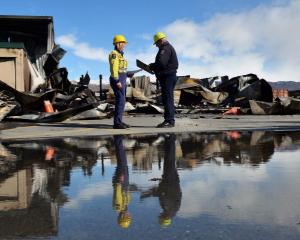Then it will be a case of tallying up the cost, fire incident controller Bryan Jensen said, estimating it will be "in the hundreds of thousands of dollars".
Who will pay may depend on the result of an investigation into the source of the fire, being carried out by two investigators.
Mr Jensen did not want to speculate on the cause at this stage, because the investigation was "vital work" which could determine who was liable for the cost.
However, firefighters - some who have come from as far away as Southland and Northland to fight the blaze in gorse, broom and scrub since Wednesday night - will get a break during Christmas and Boxing Day.
They are expected to move out this afternoon, leaving a small crew to monitor the fire area.
"If the fire flares up, we will reactivate the various people on duty over the next week," he said.
At the peak of the fire on Wednesday, seven helicopters, 63 firefighters, two bulldozers, two smoke chasers (utility vehicles) and six tankers were involved.
Yesterday, that was decreased to 50 firefighters, two helicopters in the morning, six in the afternoon and six tankers, all "going flat-out" to dampen hot spots so they could leave today.
They were also securing the buffer between the fire area and extensive forests which stretch along the Hunter Hills.
Of greatest concern was a 29-year-old, 120ha forest.
Among the crews working yesterday was one from Northland, which flew down on Wednesday night, and others from Southland.
Last night, four helicopters were sent back to their bases, but remained on standby.
A crew of four firefighters monitored and patrolled the fire area last night.
Today, a thermal imaging camera on board a helicopter will arrive to locate remaining hot spots so crews can dampen them down.
Mr Jensen would have liked the camera yesterday, but it was in demand for other fires.
Mr Jensen said the fire was now contained within the area already burnt and hot spots were "being hit hard" yesterday.
The next step would be to declare it under control, then officially out.
Fighting the fire has been tough work because of the very steep terrain in the area.
Yesterday, some crews were using ropes to get up and down slopes to find and mark hot spots.
Firefighters have to wear fire-suppressant overalls and other protective equipment, working in temperatures up to 25degC and, on Wednesday, northwest winds, hauling hoses and other equipment around.
Mr Jensen said before heading out, each firefighter was provided with lunch and water.
During the day, team leaders and sector commanders distributed further water and food.
Fire safety officers monitored crews.
"Dehydration is the biggest danger because you get so hot in the safety equipment you wear."
Mr Jensen did not know how heavy the safety equipment was, but said each firefighter had to pass a physical test on a regular basis which involved carrying a 20kg pack for 4.6km within 45 minutes.
During the Waimate fire, crews were working 14 hours or more.
While many are volunteers in rural fire parties and other brigades, they are paid a set rate while fighting a fire of this magnitude.
South Canterbury principal rural fire officer Rob Hands said conditions yesterday had improved for the firefighters, compared with Wednesday.
"We experienced a couple of flaring hot spots overnight (on Wednesday), but these were dealt with by helicopters at dawn (yesterday)," he said.
Yesterday morning started still and clear, followed by northeast winds, with a possibility of a shift to the southwest last night.




